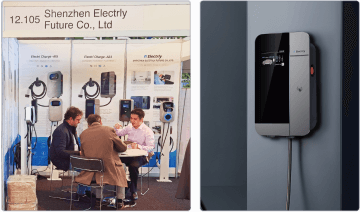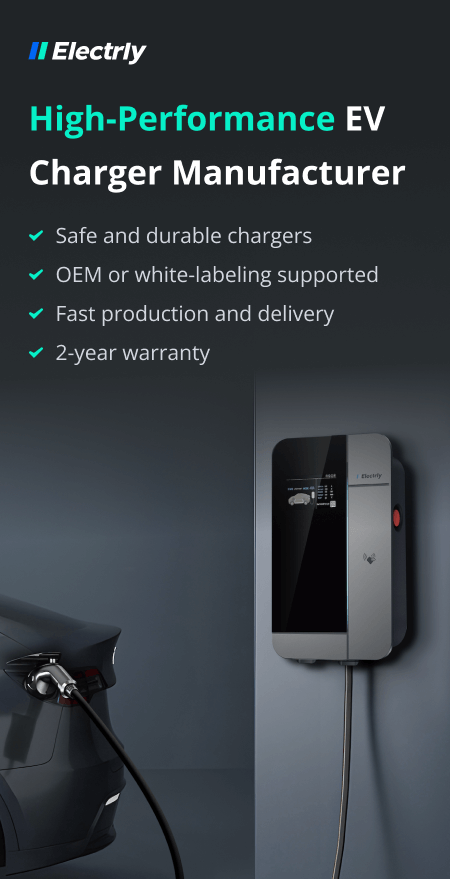Today, we would like to explore the crucial differences between Level 2 and Level 3 electric vehicle charging as we dive into their unique specifications, applications, and advantages.
This comprehensive guide from Electrly is prepared to help you understand which charging solution is best suited for your specific electric vehicle and lifestyle, ensuring you make informed decisions and optimize your EV ownership experience with the right charging infrastructure.
Basic States
Let’s start by learning the fundamental differences between Level 2 and Level 3 chargers, including their current types, power delivery, and voltage, to better understand their distinct characteristics.
Level 2
Level 2 chargers, widely used in homes, workplaces, and public spaces, employ alternating current (AC) with a 208-240V, delivering 7 kW to 22 kW of power. This charging method provides a moderate charging speed suitable for various EV models.
Level 3
Level 3 chargers, also known as Direct Current Fast Charging (DCFC) stations, provide rapid charging in public areas and along highways. These chargers utilize direct current (DC) with a 400V to 920V voltage range and power delivery between 50 kW and 350 kW, offering significantly faster charging capabilities for compatible EVs.
Charging Speed
Charging an electric vehicle depends on the charging level and the vehicle's battery capacity. Let's examine charging speeds using a Tesla Model 3 with a 60 kWh battery pack as an example.
Level 2
Level 2 charging stations provide power outputs between 7 kW and 22 kW. If charging the Tesla Model 3 at a station with a 7 kW output, it would take approximately 8 and a half hours to fully charge (60 kWh / 7 kW).
Charging at a station with a 22 kW output would take around 2 hours (60 kWh / 22 kW). The actual charging speed depends on the power delivery of the charging facility, battery size, and other external conditions.
Level 3
Level 3 charging stations, also known as DC fast chargers, can charge a Tesla Model 3 up to 80% in about 20 minutes using a 150 kW Tesla Supercharger. However, charging times may vary depending on the battery level as well as the charger's power output.
Keep in mind that with Level 3 charging, the high power load used to charge the battery can cause it to heat up. To prevent damage from excessive heat, the charging speed slows down as the battery approaches full capacity.
As a result, it's more time-efficient to use Level 3 charging until the battery reaches around 80% and then continue the journey, rather than waiting for a full charge at the fast-charging station.
Charging Ports
Different electric vehicles use various charging connectors to accommodate the diverse charging standards in the market, including Tesla's unique connectors in the US and Europe.
Level 2

For Level 2 charging, the most common connector is the SAE J1772 (Type 1) plug, compatible with the majority of EVs in North America. In Europe, the IEC 62196 Type 2 (Mennekes) connector is widely used.
Level 3

At Level 3, the Combined Charging System (CCS) charging standard is popular for North American and European vehicles, while CHAdeMO is more common for Japanese vehicles. Tesla has its own proprietary Supercharger connector in the US and utilizes a modified Type 2 connector in Europe for Level 3 charging.
Click here to check out full details regarding EV charging modes, cables, and plugs.
Application Scenarios
Various charging scenarios cater to different needs, depending on factors such as location, accessibility, and required charging speed.
Level 2
Level 2 charging stations are widely used in residential, workplaces, hotel parking, and various entertainment venues. They offer faster charging times compared to Level 1 and are suitable for overnight charging at home, topping up during work hours, or adding range while having fun in the amusement park.
Level 3
Level 3 charging stations are commonly found in large-scale parking areas, commercial charging stations, and highway rest stops, as well as public transportation systems and logistics centers. Due to their high power output and faster charging times, they are ideal for long road trips, quick top-ups, or fleet operators with tight schedules who need to minimize downtime.
Installation
Installing an electric vehicle charging station can be a straightforward process, depending on the level of charging and electrical capacity of your home or facility. Level 2 and Level 3 charging stations differ in their installation requirements.
Level 2
When installing a Level 2 charging station at your house, the first step is to consult with a qualified electrician to assess your home's electrical capacity and determine if your electrical panel can accommodate a Level 2 charger. You should discuss potential upgrades, desired charger location, charger type, needed material, permitting, and the timeline for job completion.
Level 3
Installing a Level 3 charging station is a more complex process due to the massive amounts of power they utilize. According to the U.S. Department of Energy, installation of Level 3 EVSE requires a thorough evaluation to determine the site's electrical capacity and proximity to electrical service lines. Potential upgrades to the site's electrical service may be needed to accommodate Level 3 EVSE power loads.
Effective collaboration with the local electric utility is crucial for the successful installation of a Level 3 charging station. This partnership ensures the implementation of higher capacity supply wires and transformers to meet the charger's high power demands.
Additionally, trenching or boring may be required to lay conduits, and upgrading the electrical service at the site is essential to provide sufficient capacity for the optimal operation of Level 3 EVSE.
Benefits of Using Level 2 Charging Stations Compared to Level 3 Charging Stations
While both Level 2 and Level 3 charging stations serve as great electric vehicle charging solutions, they have distinct advantages and limitations.
Affordability
Level 2 charging stations are generally more cost-effective than Level 3 chargers, both in terms of installation and usage. Installation costs for Level 2 chargers are lower, while Level 3 chargers require more complex and expensive installations.
In terms of usage costs, residential Level 2 chargers reflect on the homeowner's electricity bill, and public Level 2 chargers often have lower network charging rates. It's crucial to determine the best electric rate plan and meter system for your needs. This may involve choosing between a single existing meter or installing a dual-meter system.
Level 3 chargers, on the other hand, usually have higher usage fees in a public DC charging station due to their faster charging capabilities and the infrastructure needed to support them.
Compatibility
While Level 3 chargers work with most electric vehicles, some plug-in hybrids and EVs with smaller batteries may not be compatible with fast charging. Level 2 chargers, on the other hand, are compatible with a broader range of EVs and plug-in hybrids, making them more versatile and accessible to a wider range of drivers.
Coverage
According to the Alternative Fuels Data Center from the U.S. Department of Energy, with a total number of over 52,000 charging stations in the US, nearly 88% of them are Level 2 charging stations. Around 25% of the total Level 3 charging stations are located along the highways and only 16% of them can be found along the interstate highway system.
While Level 3 chargers are more common on highways due to their faster charging capabilities, Level 2 chargers are more widely distributed, providing better coverage in urban and suburban areas.
Future of Level 3 Charging
The future of Level 3 charging, and DC charging in general, is promising, with ongoing advancements in technology and increasing support from government policies.
Government policy changes
In the United States, the Biden administration has pledged to support the expansion of the electric vehicle charging infrastructure. The Bipartisan Infrastructure Investment and Jobs Act, signed into law in November 2021, allocated $7.5 billion for EV charging infrastructure, aiming to deploy 500,000 charging stations nationwide by 2030. (source: WhiteHouse.gov)
Infrastructure
Technological advancements and increased investment in charging infrastructure are expected to improve both the coverage and the efficiency of Level 3 charging stations. Companies like Electrify America and ChargePoint are constantly expanding their Level 3 charging networks, ensuring better coverage and accessibility for EV drivers.
Another significant development in the future of Level 3 charging is Tesla's decision to open its Supercharger network to non-Tesla vehicles. This move will not only benefit non-Tesla EV owners, but also further promote the adoption of electric vehicles in general, as more people will have access to a vast, reliable, and efficient charging network.
The opening of the Tesla Supercharger network to other brands will likely accelerate the growth and development of Level 3 charging infrastructure, contributing to a more sustainable and accessible future for electric vehicles.
FAQs
1. What makes Tesla Supercharger Network different from conventional Level 3 charging?
The Tesla Supercharger Network is a proprietary high-speed charging infrastructure developed by Tesla. While it utilizes Level 3 DC fast charging technology, it has several key differences compared to conventional Level 3 charging stations.
One of the primary differences is the speed at which Tesla Superchargers can charge a Tesla vehicle. The faster charging speeds at Supercharger stations enable Tesla vehicles to charge with a stable power delivery of up to 250 kW. That’s over 200 miles in around 15 minutes.
Another aspect that sets the Tesla Supercharger Network apart is its extensive coverage. Tesla has invested heavily in building a comprehensive network of strategically-placed Supercharger stations. The company's Supercharger network spans multiple continents and continues to grow, providing better coverage than most other Level 3 charging networks.
The most unique feature of Tesla’s Supercharger network is the streamlined connectivity for Tesla owners. A single Tesla app is all you need to charge, monitor, schedule, and pay for your vehicle charging. The convenient experience may still not be possible for other public charging stations due to different companies, different apps, and different rates.
2. Is there any potential damage to my vehicle battery when frequently using Level 3 charging?
There is potential for battery degradation when frequently using Level 3 charging, but the impact on your vehicle's battery life is generally minimal. Level 3 DC fast charging transfer a large amount of energy to the battery in a short period, causing it to heat up. This increase in temperature can lead to accelerated battery wear over time.
However, modern electric vehicles are equipped with advanced battery management systems that help regulate temperature and protect the battery from potential damage. It's still advisable to rely primarily on Level 2 charging for everyday use and reserve Level 3 charging for long trips or when quick top-ups are necessary.
3. Can I install a Level 3 charging station at home?
While it is technically possible to install a Level 3 charging station at home, it is generally not recommended for several reasons.
Infrastructure
The infrastructure required for Level 3 charging stations is much more complex and demanding than that of Level 1 or Level 2 stations. They need a substantial electrical capacity, typically requiring high-voltage connections and necessary hardware upgrades. This often makes it difficult and impractical to install Level 3 charging stations for residential uses.
Overall Expenses
The costs associated with installing a Level 3 charging station at home can be significantly higher than Level 1 or Level 2 stations. Besides the charging station itself, you would need to consider the costs of electrical upgrades, installation, and potentially higher electricity rates. In most cases, the added convenience of faster charging may not justify the substantial expenses involved.
Potential Safety Hazards
Safety is another concern when it comes to installing a Level 3 charging station at home. Given the high power levels required for Level 3 charging, there is an increased risk of electrical hazards if the installation is not done correctly or if the charging station is not properly maintained.
Moreover, residential electrical systems may not be equipped to handle the high loads associated with Level 3 charging, increasing the risk of electrical fires or other issues.


